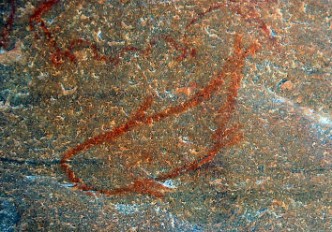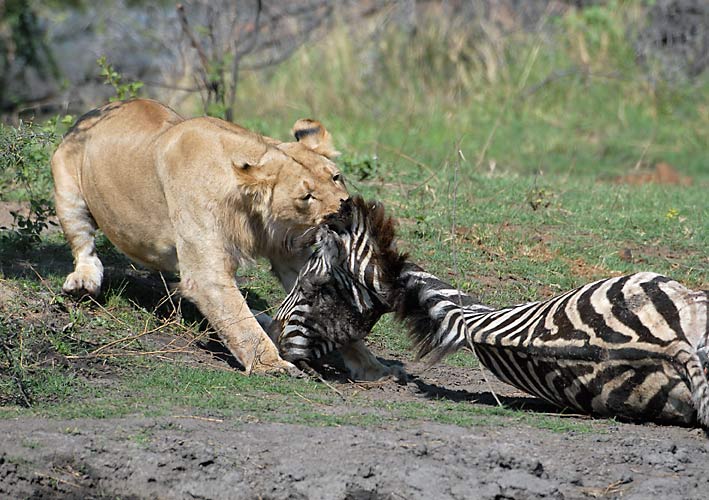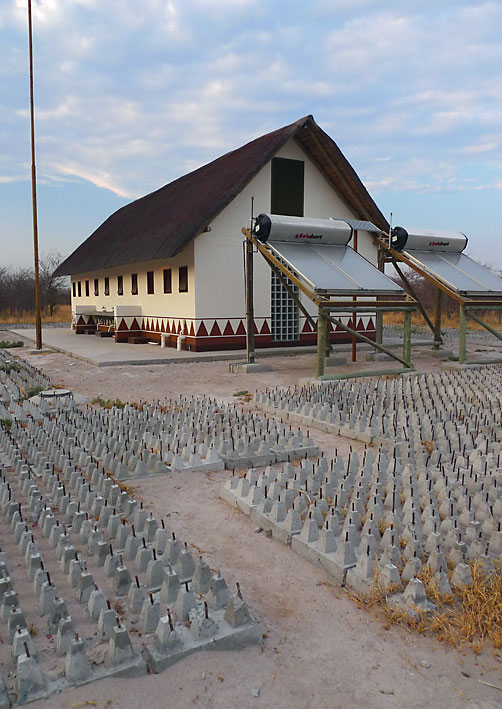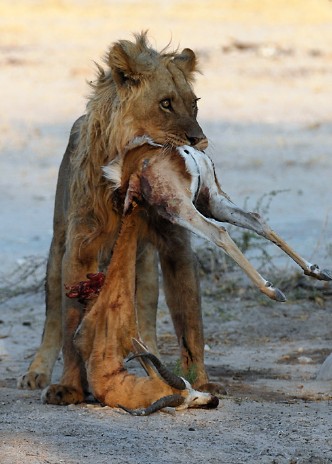Botswana
8th November - 9th November 2010 - Tsodilo Hills
Tsodilo Hills, now a World Heritage Site, has been a sacred place to the San for many millenia. It is a small group of hills that rise out of a flat and dry kalahari landscape. It has hidden amongst it over 4,000 rock paintings, some dating from many thousands of years ago, some more recent recording changes such as the arrival of settlers with ox carts and domestic animals. Some of the paintings have astonishing subject matter, for example the pictures of whales and penguins (!) that suggest the San may have visited the coast.
We took a walk over the so-called female hill and sought out some of the more famous pictures. In the evening as the sun sets, the hills glow a deep orange and you can see why they were sometimes referred to as the "bracelet of the gods". In the evening we relaxed in our campsite and soaked up the atmosphere.
 |  |
 |  |
3rd November - 7th November 2010 - Maun to Guma Lagoon Camp
We spent another couple of days at Discovery B & B in Maun, enjoying the company of the owners Rene and Marije and their guests. This was our third visit and it has become something of a home from home. It's a great place to stay if you ever find yourselves in Maun (http://www.discoverybedandbreakfast.com/Welcome.htm).
We then headed north up the panhandle and stopped for a few nights at Guma Lagoon Camp. As we had managed to spend a total of around three months in Botswana and never done the makoro ride that most tourists fit into their 5 night trips we decided to remedy this and had a lovely day out on the flats being poled through papyrus and waterlilys. It is very relaxing, though very hot in the sun. I trailed my hands in the water, until I saw a couple of crocodiles slide in off the bank. We went for a bit of stroll on an island and came across a couple of elephants, but they were too busy browsing in the trees to pay much attention to us.
 |  |
31st October – 2nd November 2010 – Makgadikgadi National Park
Like Nxai we had heard reports of Makgadigadi being devastated by fire. The drive in was certainly pretty grim but thankfully the fire had stopped short of the river which is the prime game viewing area, especially now, late in the dry season, when all the other water is gone.
There were hundreds of zebra about. We would see two or three columns crossing the road at once on their way to and from the river and groups drinking all along the water’s edge. Both the main road and the riverside are littered with carcasses and bones.
With all
the carcasses we thought we were in with a good chance of seeing some
predators. On our second morning we
found three lionesses at the fence. As
we were watching them they suddenly became much more alert and started to
stalk. There was a herd of zebra coming
down to drink behind us. By the time we
had turned the car around the first lioness had a zebra down and we watched the
zebra fight (unsuccessfully) for it’s life.
One of the lionesses got a hefty kick in the process. Then an adult and
a younger male ambled up to eat.
They
had made the kill just alongside a mud hole and a few minutes later a very
unhappy elephant turned up who obviously wasn’t expecting to find a dead zebra
in his bath. We watched as they faced
off against each other, the lions trying to move their kill away. All very exciting stuff. We saw the lions
again that evening – when they made another (unsuccessful) attempt to catch a
zebra and again the following morning.
Again the park was pretty empty, with just one other couple in the campsite. Steven and Suili had driven down from the UK via the route we plan to return so we picked their brains over the camp fire. On our last night in camp we had to make do with just two hyena for company.
 |  |
 |  |
28th October 2010 – 30th October 2010 – Nxai National Park
We didn’t really know what to expect of Nxai, or the next park, Makgadikgadi, this time around. Botswana has had exceptionally bad bush fires this year and we had heard reports of these just being smouldering rubble.
Well it wasn’t the case. There was plenty of game, especially around the waterhole where we spent many hours watching things come and go; elephant, giraffe, springbok herds, all sorts.
A pride of lions (four lionesses and two cubs) took up residence around the campsite which kept us on our toes. One morning Jerry returned from an aborted trip to the ablutions slightly ashen faced – he had met a lioness coming towards him on the path. After that we went by car ...
The ablution block at Nxai has some ingenious elephant proofing. It is surrounded by pressed concrete in the shape of a toberlerone bar with metal rods coming out of the top. A winding path through lets humans (and to be fair lions) pass but not the big guys.
It seems many other visitors had heard the scare stories too about the fires as we were almost the only people there.
 |  |
 |  |
 |  |
24th October – 27th October 2010 – Elephant Sands, Nata to Maun
Elephant Sands is famous for ... you guessed it. They often have elephant in camp drinking from the pool. Except lately there have been some big bush fires in the surrounding area and this is one of the last few square km for miles not burnt - so there are hundreds and hundreds of them. The owner, Ben, said they can drain the swimming pool (28,000 litres) every 3 hours. The restaurant is around the pool and it is quite a thing to eat with a boisterous crowd of elephants just metres away from you.
When the pool water runs out in the night they look elsewhere. They demolished the boiler outside our room at 1 o'clock in the morning and then took off the drain covers. Then they headed over to a water tank which Ben had balanced the arm of a JCB on top of to keep it secure and pushed that over too.
Back in Maun we caught up on internet and restocked. We stayed in a lovely traditional rondavel at Discovery B&B (http://www.discoverybedandbreakfast.com/Welcome.htm). A very welcome touch of luxury after all that time in the bush.
 |  |
21st October – 23rd October 2010 – Kubu Island
Kubu Island is a rocky ridge about a kilometre long and a few metres high. It is surrounded not by water but by a salt pan. It is covered in ancient baobabs and star chestnuts and has an eerie, almost prehistoric feel about it. It is sacred to the local people and has been used by them for ceremonies for thousands of years.
It’s unearthly atmosphere was only heightened by the fact it was full moon when we stayed and we watched the moon set (glowing orange in the dust) and the sun rise almost simultaneously over the pan.
It’s a truly magical spot and the pictures just don’t do it justice.
 |  |
 |  |
18th October – 20th October 2010 – Central Kalahari Game Reserve
This was one of our favourite places on our last trip to Botswana. You sometimes have to work a little harder to find the game but you feel as though you have the wilderness all to yourselves. The scenery is beautiful with wide pans dotted with tree islands.
We saw quite a few lions and cheetah but the real star of the show was the weather. The rainy season is imminent and it is incredibly hot. We saw lightning storms at night after which the sky would glow with the fires ignited in the dry bush - and trying to cook over a fire in the fierce winds that the storms bring with them was interesting.
Our highlight on the game viewing front was spending two days in the company of a beautiful young male and his increasingly smelly springbok dinner at Letiahau waterhole. The borehole had collapsed and water is drying up so he had to lap from a tiny trickle. At the same time he was constantly having to chase away the dozen or so jackals waiting for their chance to snatch a bite of springbok whenever his back was turned. He spent a lot of time carrying his prize around to keep it safe.
 |  |
 |  |
12th October – 16th October 2010 – Moremi Game Reserve
We last visited Moremi in 2007, and had a great time, but it was early days in our game viewing career and we have been to a lot of fabulous places since, so we were keen to see how it looked now.
After two years of higher than usual water levels in the area we were aware there had been problems accessing parts of the park and it turned out that our favourite area from last time, Dead Tree Island, was still under water, despite this being the driest time of the year. It also meant we spent some frustrating hours following tracks on the GPS and on maps that ended in the water and having to back track.
But Moremi is a beautiful place with a lot of different types of scenery – it was almost that rather than the game that made it special this time. That said we did see lions and leopard and some more unusual antelope like Tessebe and Red Lechwe, and the birdlife was great. We also had lions set up camp just a few hundred meters from us (which makes it a bit difficult to concentrate on cooking in the dark) and they roared all through the night just to remind us they were there.
The night before we went into the park we stayed at a community campsite Kaziikini about 30km from South Gate. It’s a lovely spot with a resident honey badger (they look benign but are in fact a ferocious creature) who rifles your bin. I can tell you on good authority that honey badgers like carrots – but not onions or sweetcorn.
 |  |
5th October 2010 - 11th October 2010 - Chobe National Park
The Kazungula border crossing wasn't nearly so bad as remembered and we were through both the Zambian and the Botswana sides in under two hours after only having to part with $28 for the priviledge of leaving Zambia (last time it was at least three times this).
We were really looking forward to Chobe - and had a booking for four nights at the beautiful Ihaha campsite in the middle of the park. Like most Botswana parks this has recently been privatised and our bookings were under the old system so we were slightly nervous ... but all was fine.
The riverfront is almost unrecognisable since we were last here in April. The wide channel of water is now just a gully a few feet deep in places and you can drive across the flats which were all underwater on our last visit.
The game was stunning. On our first drive we saw a leopard with it's kill under a tree. The next day another leopard posing beautifully in a tree. Each evening we saw huge herds of elephant (easily a total of hundred in sight at any one time) and we came across an enormous herd of buffalo (1,000+) a few times.
One night we had elephant in camp. I could hear one sniffing us up in our roof tent!!
And a few reminders of the darker side of life in the wild. An elephant carcass with the vultures, storks and hyena fighting for the best pickings. And a baby elephant who had somehow become separated from his herd. We left him hiding in a bush and said a little prayer that his family found him before the lions did.
.jpg.opt318x441o0,0s318x441.jpg) | .jpg.opt309x445o0,0s309x445.jpg) |
.jpg.opt315x443o0,0s315x443.jpg) | .jpg.opt316x447o0,0s316x447.jpg) |
After 4 days at Chobe riverfront we headed for Savuti. The Savuti Channel, running again for the first time in 20 years or so was going strong. They are building a bridge over it which is just as well as the crossing is getting a bit hairy.
The game was quiet after the spectacle Chobe riverfront had to offer. That is until the morning we left. We had just pulled up to the river for a cup of coffee when a female kudu ran between the car and the river and plunged into the water. Hot on her heels came a pack of wild dogs who also piled in, swam the river and took up the chase again on the other bank. It is special to see wild dogs - one of the rarest animals you may encounter on safari - but to see them hunting is another matter. A real once in a lifetime event.
 |  |